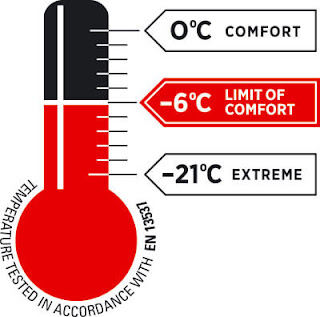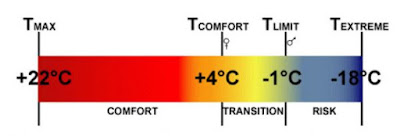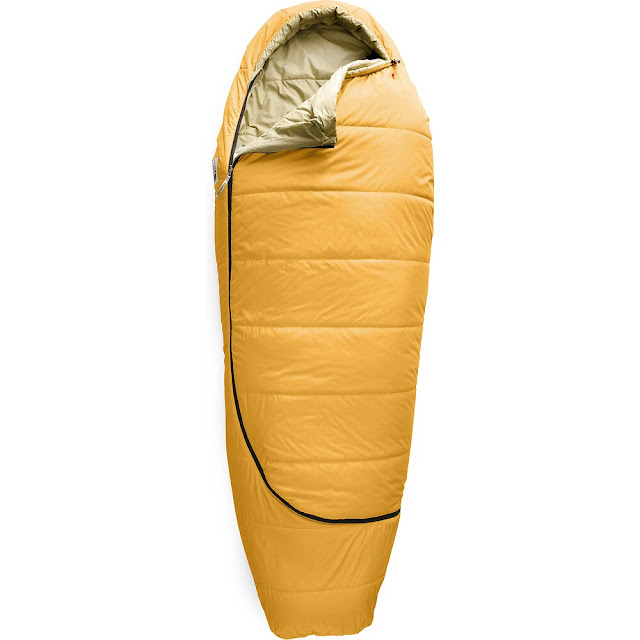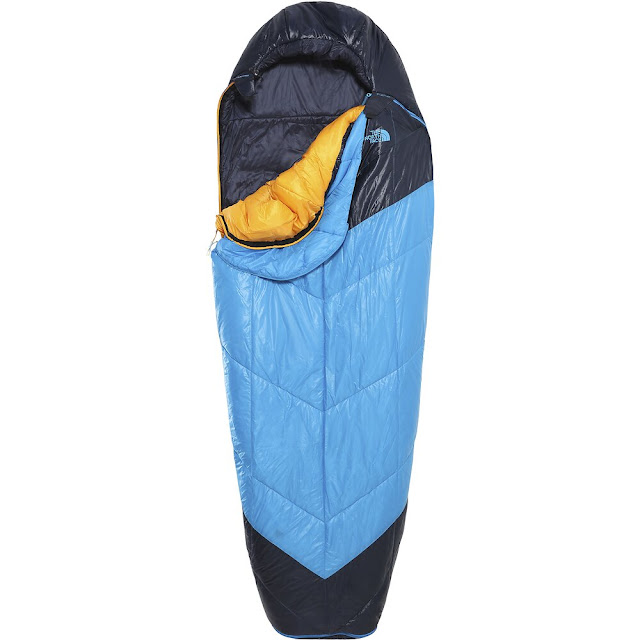
Is it time for you to get a new sleeping bag?
Maybe your current one is showing the signs of wear and tear? Or you want to upgrade to a warmer or lighter sort of bag?
Possibly, this could be your first ever purchase of a sleeping bag (which means you could be a little amazed by the variety on the market).
But how do you choose a sleeping bag?
What do you look for in a sleeping bag?

I am going to tell you straight up – it’s not easy.
There are so many things to consider.
If you go into a camping store there are a few things you need to know before you go, to make the right choice. It’s thinking about how you like to camp, where you camp, and of course, the weather you camp in.
With that in mind, read on to find out 5 tips to choosing the right sleeping bag.
1. Temperature Rating

The temperature rating on a bag is a guide (and I stress the word, guide) on the lowest temperature the bag is designed to keep you warm in.
So a bag that has a rating of 5 degrees Celsius, should theoretically keep you warm when the mercury gets to 5 degrees.
But will it?
The manufacturers testing of this temperature rating isn’t known, and a lot of factors also need to be considered on how effective that bag will be. Your sleeping mat, if you are a warm or cold sleeper, the clothes you are wearing in the bag, the shelter you are in during the night, etc.
All factors that might alter how you feel in the bag.
So what do you look for in a rating?
Think about the lowest temp you think you will be camping in with this bag (not just the first trip, but any trip you are planning on using it). Then subtract 10 degrees from that temperature. And with that new temperature, choose a sleeping bag with that rating.
eg. You think the coldest place you will camp in will be about 0 degrees. Choose a bag rated to minus 10 degrees.
This might seem a little excessive, but it’s easier to cool down in a too-warm sleeping bag, by unzipping it. Trying to get warm in a not-warm-enough bag is harder (and can lead to a sleepless night).
How warm you will be affected by your shelter and what’s underneath you. A sleeping mat is a purchase you will probably look at in conjunction with sleeping bags. Read the link below for information on that.
Further reading: How to choose a self inflating mat
What about the ratings on the bag?
You might see on a sleeping bag, 3 levels of comfort rating and this is based on the EN 13537 rating, which means it’s the official European standard for the labelling of sleeping bags.
Comfort – that’s what a standard night sleep would be like for a ‘standard’ woman because women need more insulation than men apparently. It’s the warmth level that women would like for a comfortable night’s sleep.
Limit of comfort – This is the lowest temperature that a ‘standard’ man would need for a comfortable nights sleep. I am not sure what constitutes a ‘standard’ man, or woman (as above mentions) but it assumes you are not sleeping naked and have some insulation underneath you.
Extreme – This is the coldest temperature you can survive in, in this particular bag without freezing to death. Now under the standard EN13537 for sleeping bag ratings, they classify this ‘extreme’ rating as follows, “a strong sensation of cold has to be expected and there is a risk of health damage due to hypothermia”. Of course, you shouldn’t be relying on any sleeping bag to save you from hypothermia, and use this as a guide only.
Here is an example of what you can see on the bags:
 |
| Found on One Planet bags |

If you want to read more about the EN 13537 rating standards and validity, there is a paper from the Outdoor Industry which discusses in detail.
What about the temperature rating on children’s sleeping bag?
It wouldn’t be ethical for tests to be done on children to test the temperature range. The ratings on a sleeping bag are based on adults – which have different physiological and physical differences. Some sleeping bags will go with age recommendations as opposed to saying what the temperature rating is, and that is based on scientific data which you can read here if interested.
A summary of this data surrounding children sleeping bag ratings concluded
“The model predicted lower temperature ratings for younger children (under 12 years old) than adults. Younger children were found to have a lower temperature rating due to a higher metabolic rate” Source here
2. Synthetic or Down filled
 |
| North Face – Eco Trail Synthetic. Rated to 2C. Good for car camping. |
Another big choice will be the filling for the bag. Do you choose synthetic or down?
What is the difference?
Synthetic –
- cheaper than its same rated down counterpart
- heavier and bulky
- has insulation properties when wet
- easy care
- hypoallergenic
- Not as long-lasting – will deteriorate over time
Down –
- lighter
- longer lasting than any synthetic when cared for
- expensive
- no insulation when wet
- highly compressible so takes up very little room
- warmer than any synthetic available
- more difficult to care for
- not hypoallergenic
They both have pro’s and con’s about them as you can tell.
But what one to choose?
That will come down to your budget and your style of camping.
Down is a good long term choice, and will suit anyone – and where weight and bulk is a consideration, you can’t do better. There are different sorts of down too, and that affects price and warmth in the bag as well. The higher the concentration of down feathers, the better. So a down of 850+ is superior to one of 600+. Simple!
Some people think down sleeping bags are a bit scary when it comes to cleaning – it’s not too bad. You just need some time to do so. Read how to wash a down sleeping bag here.
Hikers who need to minimise weight will find down sleeping bags the only practical option for them.
Synthetics are good if you plan on being on in wet conditions, and on a budget. And if you don’t plan on being a regular camper – the more casual or not so sure about camping sort of person, then this will be a good choice and an economical one.
You might find if you enjoy camping, that you need to upgrade later.
 |
| The North Face “One Bag” Down-filled, multi-layered sleeping system. For those who want a wide range of layers to keep them warmer or cooler. Expensive but excellent quality. Probably on the heavy side for hikers. |
The Ethical Use of Down
Before we move onto the next point, it’s very important that we mention the use of down and the ethical treatment of animals to produce this down. This was raised in comments when we first published this story, and it was remiss of us not to address at the time.
When purchasing a down product (whether it be a sleeping bag or a jacket), you should check that it was ethically sourced.
Unfortunately, big business means ill-treatment of animals in the past, and the down from ducks and geese have meant extreme cruelty against these animals. It still goes on, but you as a consumer can make a choice. That means looking for companies that follow the Responsible Down Standard. It’s a voluntary standard, so not every company will participate so you need to do some homework.
- Read about the Responsible Down Standard and what it means here.
- The list of outdoor companies that use this standard can be found here
- Patagonia has its own Traceable Down Standard.
Is this RDS a guarantee? I am not sure….there can be no guarantees.
PETA has recently put out information saying the unethical treatment of animals continues. You can read their current story on live-plucking. It is very distressing to read and see.
3. Shape
The shape of the sleeping bag varies, and the main shapes you will come across is the mummy, tapered rectangular and rectangular.
- A mummy-shaped is probably the most efficient. (see image below).
 |
| Nemo Kyan 20 Synthetic Mummy Bag |
It’s wide at the shoulders and then narrows down to the feet, which means less air needs to be heated in the bag. Less room to wriggle about, though, so if you like to toss and turn in your sleeping bag, this might be a little restrictive.
In terms of thermal efficiency, it is the best option. If you think you could find this sort of shape of bag constrictive, you could look at a mummy bag that has a zip that goes all the way down the side, so you could open it up if required.
- Tapered rectangular is just as it sounds.
They taper down to the foot of the bag, like the mummy, but not as much. More wriggle room and a good all-rounder shaped bag.
 |
| Roman Palm Lite |
- A rectangular bag is…..rectangular!
Even more, wriggle room, and tend to be the sort of bag you would use if you don’t have to worry about weight or size. This is a generalist shape bag, and will not come with many fancy features or technical designs.

4. Fit (based on the individual)
This goes together with the shape (point 3). It’s about finding a bag that suits you. Not only do bags come in different shapes, but different sizes too.
eg. The Darche 1100 Cold Mountain (pictured below) is for the larger person or a person who likes room in their bag. 250cm x 114cm. So that is the sort of synthetic bag that would suit a car camper who doesn’t want to be constricted. Rated for -12 degrees.

Some bags are different lengths to cater for tall or short people. If you are tall, you don’t want to be squishing yourself into a bag which is uncomfortable. When buying a bag, check the measurements and get one that is for your size. Many bags come in LONG, so do look for that feature in conjunction with all the other features.
eg. The Sea to Summit Ascent 3 Down Sleeping bag – Long, (pictured below) is recommended for someone up to 198cm and the regular version is for up to 183cm. So that is quite a difference. Sea-to-Summit have many different down and synthetic bag that come in both long and regular.

Women are considered cold sleepers. Therefore there are bags that are designed specifically for them, but that is not to say that they are only for women. And of course, a woman can choose any bag, not just one designed for them. If you are a cold sleeping woman, you may want to look at a sleeping bag designed for women or choose a warmer sleeping bag.
eg. The Sea to Summit Quest 1 Qui Women’s Synthetic Bag – Regular size (pictured below) It is a tapered sleeping bag, wider in the hip area, and narrower in the shoulders. Comfort level rating of 3 degrees celsius, with a lower rating of -3 degrees.

Are you looking for a double sleeping bag?
If so, read how to choose a double sleeping bag in this story. Double sleeping bags have many of the same features you look for, but we explain in greater detail about how to choose one and what you need to look for in greater detail.
Pictured below is the Sea to Summing Basecamp 2 rectangular sized double sleeping bag. (pictured below) This is for regular size (up to 183cm), with 3 2-way zips.

Children – do they need their sleeping bags fitted for their size? We say yes. To find out why we think children need an age-appropriate bag, read our story on Kids Camping Gear – What to buy and what not to buy
Children sleeping bags are a great idea, but as the link above mentions, it is important to get the right one for children.
5. Extra features
The little touches are important when choosing a bag but some are not necessary, or must-haves. Just features you can review with each bag you look at.
- Look at the zippers – Do they close up easily, or snag a lot on the lining? Do the zips lock in place when pulled up? Do they go all the way to the bottom or only halfway (the former means the bag can be opened up easily to cool you down if you get too hot)? Left or right-hand side?
- What is the lining made of? Polyester or nylon breathes and draws away moisture. Cotton (like flannelette) is comfortable but moisture stays with you and can leave you feeling damp.
- Neck muff – holds the warmth in the bag, not letting it seep out.
- A hood – allows you not to wear a hat when in the bag, and provides a soft spot for your head. Some hoods will have a drawstring that will only show your face when drawn in.
- Do they come with pockets (some have places where you could store small items)
- Stuff sack and mesh bag – when possible, you should store the bag out of the stuff sack and in a mesh bag. It’s great if your purchase has both these items.
- Pillow pocket – a pocket where your pillow slides in to prevent it from moving around in the night.
Whatever the sort of sleeping bag you want to choose, do your homework.
(Double sleeping bag information is found in this story)
Editors Note: This story has been updated to reflect changes and improve accuracy.


